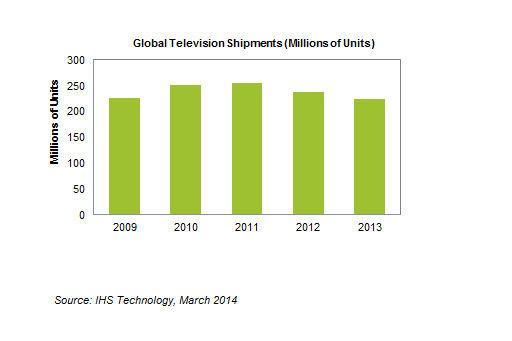Global TV Shipments Contract for 2nd Straight Year in 2013, Recovery Ahead: IHS
2014/03/27 | By Quincy Liang
The global TV market shrank last year for the second year in a row, with total shipments declining by 6% to 225.1 million units from the already soft 2012 level of 238.3 million, according to a new report from IHS Technology. This followed a 7% loss in 2013 following increases of 11% and 1%, respectively, in 2010 and 2011.
"The global TV market continues to be in transition following a golden period of tremendous growth from 2009 to 2011," said Jusy Hong, principal analyst for consumer devices at IHS. "Television shipments were down again in 2013 just like in 2012, but an unusual development was the slow market last year in China, Asia-Pacific and Eastern Europe—until recently among the brighter spots for the industry."
Adding to the market's woes, Hong added, cash-strapped consumers in North America and Western Europe showed little appetite for buying new TVs, especially as these areas are now nearly saturated with flat-panel sets.
China Market
China suffered a notable reversal during the third and fourth quarters of 2013 as the country's LCD TV market declined compared with the same quarters a year earlier—the first time decline ever. Growth in the China TV market is increasingly hard to come by, and an expired central-government subsidy program for new appliances has removed a powerful incentive for consumers to purchase new TVs.
LCD TV shipments in China during the third quarter of last year fell to 13.0 million units, down from 14.0 million a year earlier. Fourth-quarter shipments suffered a similar decline, from 14.5 million to 14.4 million units. Still, China's overall LCD TV shipments for the year as a whole were up from 2012, thanks to a strong first half.
In the overall Asia-Pacific region, LCD TV shipments last year totaled 23.8 million units, down from 25.4 million in 2012, with the option to buy cheaper sets fast disappearing from the regional market. With light-emitting-diode (LED)-backlight TV sets still being beyond the reach of many consumers, TV demand in the Asia-Pacific plummeted last year and continues to remain in a holding pattern as consumers hope for prices to come down, Jusy Hong noted.
The WestFor North America and Western Europe, once the most powerful engines of the global TV industry, the weak state of the market continued to disappoint. Overall TV shipments in North America fell 9% last year, while Western Europe showed an annual loss of 4%.
The TV market for both regions now consists entirely of LCD and plasma TVs, with none of the analog, tube-type TVs that can still be found in other territorial markets such as the Middle East-Africa, Latin America, and the Asia-Pacific.
In Eastern Europe, LCD TV shipments were off last year by 14%, reflecting financial troubles on the European continent. Also, TV vendors in the region were less enthusiastic with their promotions after suffering a profit decline due in part to disadvantageous exchange rates between the euro and Asian currencies like the Japanese yen and the South Korean won.
OLED TVs
Following last year's sober performance, worldwide TV shipments are projected to improve. The developed markets of North America, Western Europe, and Japan will stabilize in the coming years, and no large declines like those of last year are forecast for the immediate future, Hong said. At the same time, significant growth is expected in China, the rest of the Asia-Pacific, Latin America, and the Middle East-Africa.
Latin America, in particular, will experience a surge in sales for numerous reasons, including expected economic growth, the FIFA World Cup soccer championship there later this year, the analog-to-digital changeover in 2015, and the Summer Olympics in 2016.

The IHS report predicted that worldwide TV shipments will start climbing this year because of the new active-matrix organic light-emitting diode (AMOLED) TV sets entering the market, making their appearance at retail outlets in noticeable numbers for the first time. Featuring thinner profiles and higher contrast ratios than the current crop of LED-backlight LCD TVs, OLED TVs will see annual shipments grow from an initial low base to some 8.1 million units by 2018.

